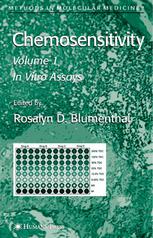

Most ebook files are in PDF format, so you can easily read them using various software such as Foxit Reader or directly on the Google Chrome browser.
Some ebook files are released by publishers in other formats such as .awz, .mobi, .epub, .fb2, etc. You may need to install specific software to read these formats on mobile/PC, such as Calibre.
Please read the tutorial at this link: https://ebookbell.com/faq
We offer FREE conversion to the popular formats you request; however, this may take some time. Therefore, right after payment, please email us, and we will try to provide the service as quickly as possible.
For some exceptional file formats or broken links (if any), please refrain from opening any disputes. Instead, email us first, and we will try to assist within a maximum of 6 hours.
EbookBell Team

4.3
88 reviewsChemosensitivity testing is an ex vivo means of determining or enhancing the cytotoxic and/or cytostatic, or apoptosis-inducing effects of anticancer drugs. In Chemosensitivity, leading researchers and physicians working in academia and biotech companies describe state-of-the-art laboratory methods for assessing chemosensitivity in vitro and in vivo, and for assessing the parameters that modulate chemosensitivity in individual tumors. Volume 1: In Vitro Assays provides a panel of 16 in vitro measures of chemosensitivity in adherent and nonadherent cells for single agents and combinations of agents. In addition to immunohistochemical and imaging approaches, these assays include clonogenic, colorimetric, fluorometric, and physiological assays. Highlights include image analysis to assess drug sensitivity, high throughput approaches using green fluorescent protein, DIMSCAN (a microcomputer fluorescence-based assay), and the ChemoFx assay used in biotechnology. The protocols follow the successful Methods in Molecular Medicine™ series format, each offering step-by-step laboratory instructions, an introduction outlining the principle behind the technique, lists of the necessary equipment and reagents, and tips on troubleshooting and avoiding known pitfalls. The authors also provide guidance on how best to analyze the data derived from the protocols. A companion volume, Volume 2: In Vivo Models, Imaging, and Molecular Regulators, provides protocols for classifying tumors into response categories and customizing chemotherapy regimens to individual patients.
Cutting-edge and highly practical, the two volumes of Chemosensitivity provide a comprehensive collection of readily reproducible techniques for the in vitro and in vivo screening of new agents and a set of proven approaches to understand mechanistically why certain cancer cell lines (in vitro) of tumors (in vivo) are more, or less, sensitive to a particular agent.